Is anybody listening to records managers? ANZ reader survey.

Are you worried that the message about information and records management is not getting through to your colleagues? Do you spend your time devising strategies to encourage use of the corporate EDRMS but find its falling on deaf ears? Is email management or the lack of it causing sleepless nights? If you answered yes to any of the above, then relax, you’re not alone. An IDM survey of Australian and New Zealand records and information managers has found some common concerns at the top of everybody’s list.
While there are many difficult technical challenges to be overcome in implementing an electronic document and records management system (EDRMS), the survey found Australian and New Zealand organisations finds the major perceived challenge comes from end users resistant to change.
Submissions were received from a wide range of over 250 public and private sector organisations, with many at differing stages of the path to digital records management.
One of Australia largest independent oil and gas companies is in transition to digital records management with SharePoint and the InfoVision EDRMS. Staff are still printing documents to be retained as records.
“I think the awareness is on the way up. Although Records Awareness Training is mandatory, I suspect that it is seen as a hindrance,” notes the company records manager.
The records manager at one of Australia’s major infrastructure providers for utilities, construction and mining, listed on the stock Exchange with over 1000 staff and $400M annual turnover, is using an email archive for Outlook and has introduced a SharePoint document management system for controlled documents.
“But records management for other types of documents is very much still hard copy”.
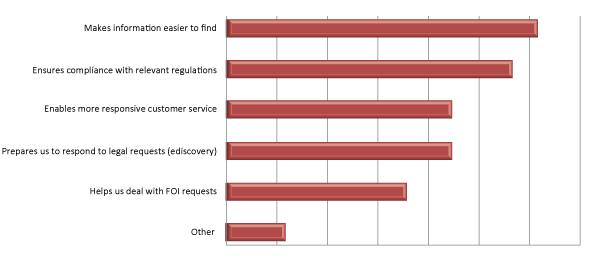 One government records manager commented “The nitty-gritty of RM is only important when it affects senior management's ability to find data or documents instantly. Compliance only gets attention when it comes to a tick on the CEO's performance agreement.
One government records manager commented “The nitty-gritty of RM is only important when it affects senior management's ability to find data or documents instantly. Compliance only gets attention when it comes to a tick on the CEO's performance agreement.
For this small state agency, without the funding for an EDRMS rollout, the responsibility rests with the users to follow the agency’s file plan on a shared drive.
“Most users have their digital records fairly well organised on their own computers. Backing up is an ongoing issue. Most users follow the agency's file plan. However, few users pay heed to preservation requirements.
“Consequently we have had two recent cases of lost email and other data due to HDD failure and no backup.”
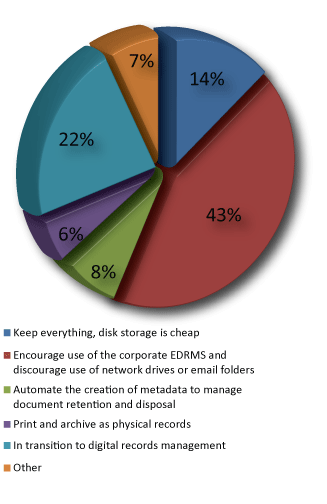 Another records manager notes, “Currently, the policy is print & file. Not everyone adheres to that policy. E-documents are stored in business systems which don't have retention/disposal applied. We're in transition to an EDRMS, but it's been moved down the list of competing priorities.
Another records manager notes, “Currently, the policy is print & file. Not everyone adheres to that policy. E-documents are stored in business systems which don't have retention/disposal applied. We're in transition to an EDRMS, but it's been moved down the list of competing priorities.
“Most users consider it to be an "after the project" task. By the time the project's finished, the momentum's gone and it's easier just to chuck it all in a box & send it off site. Bunging information into a spreadsheet is seen as easier than using the existing hardcopy RM system.”
Narelle Haken, Records Officer at the Compensation Authorities Staff Division (CASD) of WorkCover NSW, said, “A RM Strategy is required to be pushed and backed from the top (management) to enforce/enable a strategy that is seen as part of the way we work and not enable silo workarounds.”
At a large council running OpenText eDocs as their EDMS, despite attempts to put controls in place around where documents, spreadsheets and emails are saved, “The reality is that the product still has holes that other users have learnt and teach to the new starters straight after our induction,” said an IT Officer.
“Even with every good intention and policy in place, the reality is that it is still a pipe dream. No matter how many times you stress that email is not a database or document management system, the reality is that to the end user their mailbox is their data store. Invest in a good email archiver and budget for lots of disk storage. The concepts are understood within the Records Management and IT sections but getting the message out to the rest of the organisation is the real challenge.”
Colin Thornton is Senior Analyst in the Enterprise Content Management team at Powercor, the utility responsible for delivering electricity to homes and businesses in Melbourne and through central and western Victoria.
The team looks after the systems such as SharePoint (which serves the Corporate Intranet, collaboration Team sites and a Contractor Extranet); OpenText LiveLink for records management and a large-scale drawings management system (Bentley Projectwise).
The team also provides application support for the web content management system of the externally hosted corporate Internet site, serving over 1.2 million Powercor, CitiPower and Wellington Electricity customers.
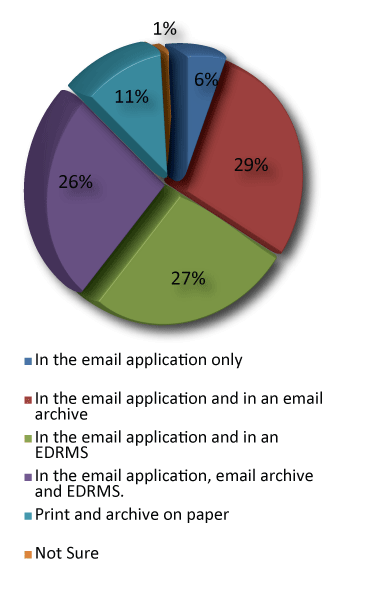 Powercor is well established with an ECM platform, intranet and collaboration. But general staff are still printing documents to be retained as records.
Powercor is well established with an ECM platform, intranet and collaboration. But general staff are still printing documents to be retained as records.
“At this point the records management policy only allows physical records. We have growing momentum in the business to start considering electronic records, but at this stage the business hasn’t included the requirement to include electronic records in the policy,” said Thornton.
“There are a number of information types, such as technical standards that we deliver to external contractors, that are not considered records. As physical record management begins to expand, more and more people in the business are starting to question what we consider records.”
Printing records also extends to email, which is managed in Microsoft Exchange and Symantec Enterprise Vault. All email is archived permanently to tape, so everything is there to be found if an issue arises in the future, it’s just the discoverability that could be a concern.
“The push from IT is to begin to put more and more current working documents into SharePoint. Once they’re in there they’re quite easily searchable, so it accomplishes our goal of making information easier to find,” said Thornton.
“For many of our organisations here and in Asia physical records management is as important as electronic,” said Graham Pullen, Vice President Asia Pacific at OpenText.
“Being able to find the physical record is just as crucial as discovering it in the electronic repository.
“The number of organisations in transition to digital records management shows people seem to be understanding it’s a logical journey, its accepted now that organisations need the governance and controls around their corporate information, which is a huge move forward from even five years ago.
“Most organisations neither want to destroy everything or keep everything any longer than they have to.
“It is a very important part to make it transparent to the users as modern RM systems do. It is important to discourage the use of personal drives. The ability to automatically populate forms is taking away a lot of the concerns of the end user.”
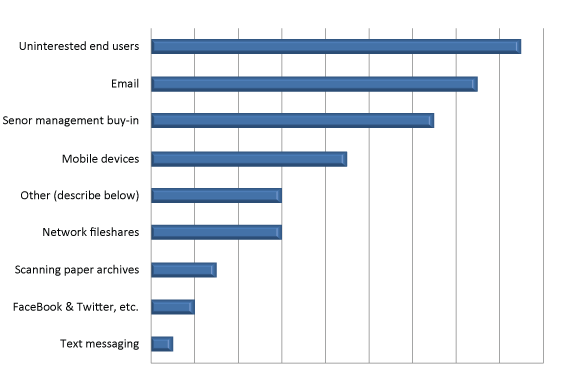 Email is clearly regarded as the major records management challenge. Organisations are adopting different strategies to manage retention in their email application, dedicated email archives and EDRMS systems.
Email is clearly regarded as the major records management challenge. Organisations are adopting different strategies to manage retention in their email application, dedicated email archives and EDRMS systems.
“Email is a big issue,” noted one federal government CIO.
“An Exchange database is not an official RM platform, so staff should be putting emails into TRIM but a lot of times that does not happen.
“This can cause problems if people leave and you need to find out about the basis of decisions they made in the past. It’s not ideal to be looking through Outlook folders for people that are long gone to try to find out what was said by whom.”
“People need to figure out what are the important emails relating to business decisions and filing them appropriately in TRIM. We can make the interfaces as easy as possible but they still have the responsibility to work it out.”
Abie Spies, founder and Managing Director of Engineering Informatics, a product-independent Enterprise Content Management (ECM) consulting company, said, “I don’t know of any organisation that truly have rock-solid email records management, and I don’t think it will change.
“The issues are too big and complex, and the business drivers not compelling enough for most organisations to pay more than lip service to email RM (as opposed to ‘email handling and using’, which most organisations are pretty good at!).
“In any case, the whole phenomenon of ‘email’ probably has a shorter lifespan than we can imagine. 20 years ago it was unknown, and in another 20 it will probably be forgotten. Already we are starting to see a decline in email use as social media takes a bigger share of communication – which is bringing a whole new set of headaches to RM.
“In any business, there are always a lack of time and money to do everything that ‘must’ be done, and different business processes (including RM) compete for available resources. Business spends money and effort where the perceived value is the greatest.
“The fact that most organisations are so lacking in RM, is purely due to the fact that the perceived value is much less than for ‘competing’ business processes. That’s a fact of business life! If RM wants to compete on an equal footing, it can only elevate its stature by providing more perceived business value.
“The big stick of ‘regulatory compliance’ is one way of scaring executives into giving RM higher stature, but in the long run, only real business value will be sustainable; and RM can achieve that by focussing on delivering decision critical information where it is needed, when it is needed, in the format it is needed, and without any surplus noise. Do that effectively, and you’ll get business executives’ attention.”
Staff challenge
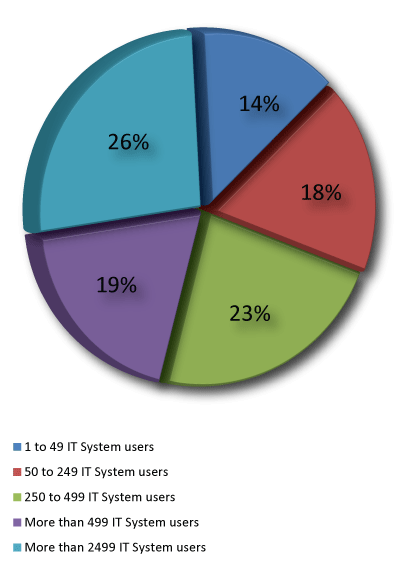 A records manager at a major commercial law firm with offices throughout Australia and more than 325 staff, noted, “As we progress in the electronic age, encouraging the maintenance of full electronic files becomes more of a challenge as well as helping staff understand the importance and relevance of it.”
A records manager at a major commercial law firm with offices throughout Australia and more than 325 staff, noted, “As we progress in the electronic age, encouraging the maintenance of full electronic files becomes more of a challenge as well as helping staff understand the importance and relevance of it.”
“With a growing library of information stored off site it is crucial to be able to locate the right documentation quickly either for external or internal requirements.
“We are encourage use of the corporate EDRMS (Interwoven TeamSite) and discouraging use of network drives or email folders. We have a major challenge to scan our paper archives.
“As a law firm our strategy for maintaining full electronic files is well implemented, but old habits die hard and forming new habits to keep a full electronic file are slow to build. For our business services units there is a less well defined path and more work is required.”
“Moving email to our EDRMS is a bit haphazard and not well managed, and In some cases records management seems to be viewed as a "necessary evil"
The sentiment was echoed by a records manager at a major Australian bank, which is currently in transition to digital records management with OpenText ECM, although staff are still printing documents to be retained as records.
“Uninterested end users are a big challenge,” she said.
A records manager at a Victorian local council with more than 500 users said, “Emails form a large part of business decisions and need to be appropriately captured.
“We are progressively encouraging staff to use ‘drag n drop’ function to move emails to a network drive. Gradually we are reducing archive (pst) files as these can be poorly managed and can hold a large portion of corporate data.”
“We are proactively working with business units in developing SharePoint sites. In the future it is hoped to purchase RecordPoint which therefore makes the system VERS compliant & for small business is an ideal, cheaper alternative than purchasing & implementing large ECM systems. “
Forrester Research has named RecordPoint as one of six technology partners that Microsoft perceives to be important in supplementing the enterprise records management capabilities within SharePoint 2010. RecordPoint was highlighted by Forrester in particular as providing support for Australian, New Zealand and European regulatory requirements.
“However like any organisation it is more than just new systems it is a matter of educating staff and getting the ‘buy in’ option in order for the business to move forward,” said this council records manager.
Council staff are still printing documents to be retained as records and an email archive is used.
“Records management assists staff with FOI/RFI requests, helps to make formation discovery easier & more reliable, significantly assists with customer service enquiries and more importantly ensures that the organisation is compliant with relevant legislative requirements & regulations.
“The strategy being implemented I believe is working well across the organisation. It is more of an education process in reminding staff of their responsibilities and obligations when handling or creating electronic data. I think staff understand them well it is just getting them to implement or abide by policies which is sometimes frustrating.”
Robert Fraser of industry consultants Trinogy Systems, said, “email continues to be the ‘problem looking for a solution’ in document management terms. I get the sense that records departments and end-user have still not connected in terms of purpose of meeting corporate and regulatory obligations – records folk still lean to records based products which end-users find difficult and cumbersome.
“End-users obviously still don’t understand why they need to use an EDRMS – much more needs to be done here by vendors, associations, media, government – as information awareness increases due to Web 2.0, etc. the general person will be demanding easier access to ‘documents’ and corporate information.
“In my view, organisations that have managed to make the EDRMS their Windows filing system, i.e. deny access to local and network drives and enforce storing/retrieval of all corporate ‘documents (emails, word, etc) are the ones that have the best chance of success in meeting records sentencing/disposal, document retrieval and best-practice for managing the explosion of documents – but these can be counted on one hand.”
A difficult combination
Mergers and growth by acquisition can often present challenges to settling on a singular EDRMS strategy. The WA Department of Environment and Conservation faces a difficult task merging the divergent backgrounds of two separate departments, one that was using TRIM for managing paper archives while the other had started on the road to electronic document and records management with Objective.
“We have Outlook archiving but we are pushing people to save directly into Objective from inside their email, said Bronwyn Cropley, a Project Officer in Corporate Information Services.
“People are really aware that they are working in a group and the group needs to see what they are working on.
“People are very good at recordkeeping on their shared drive within their internal department or office, we need to convince them they can do as good a job inside Objective.
Currently we only have a 50% takeup of EDM in areas that use Objective. Other people will avoid it or just use the shared drive.”
Sean Guillemot, Partner Manager (ANZ) for Perceptive Software said, “The uptake of Records Management in corporate Australia is generally not as advanced as in the U.S., which is driven by increased e-Discovery needs and stronger governance, such as the FRCP (Federal Rules of Civil Procedure).
“Many ECM companies have traditionally imposed their will on their customers, forcing them to adopt yet another User Interface and endure heavy Integration requirements. The ECM game is changing and becoming more versatile. Providing content services within the context of the customers’ applications is what it’s all about.”
Clive Gold, Marketing CTO for EMC Corporation Australia and New Zealand, was surprised to see that most organisations responding to the IDM survey still identify the big problem is still finding information.
“It does seem like a bit of a catch-22, as the users don’t want to be involved in classifying information which would help them find it later.
“It is also a worry that so many organisations still believe that printing is the way to manage electronic data. A recent IDC study suggests that if all the digital data created this year was put onto iPads, there would be enough devices to build the Great Wall of China twice.
“It is interesting that respondents are most worried about email, in a time where the world is moving to more instant and collaborative ‘social media’ mechanisms and these did not seem to show up in this survey,” said Gold.
